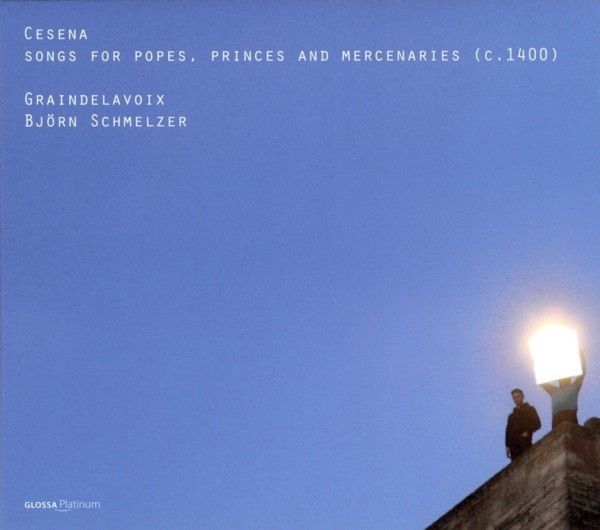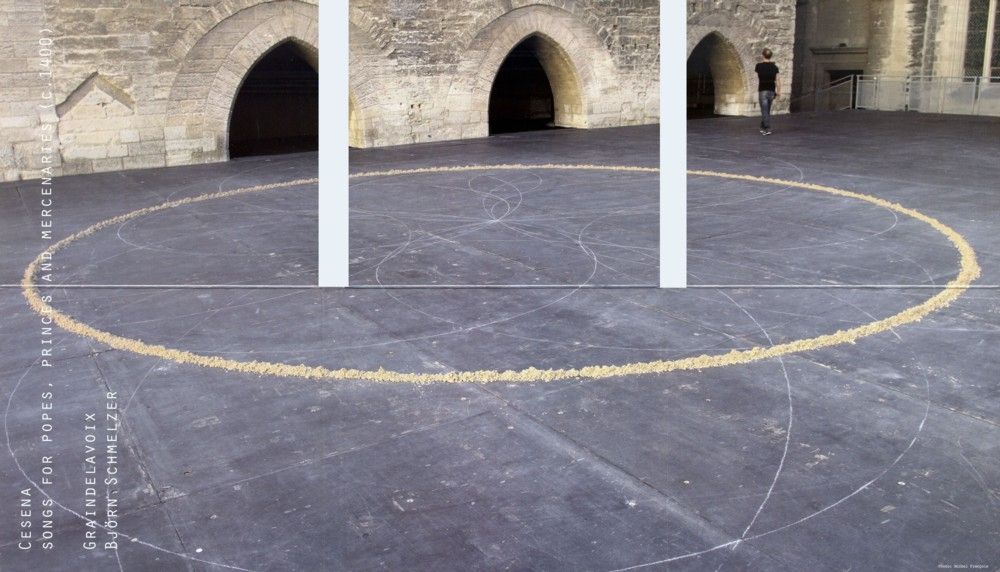
glossamusic.com
diverdi.com
medieval.org
Glossa GCD P32106
2012
01 - Pictagore per dogmata ~ O terra sancta ~ Rosa vernans caritatis [3:29]
OA, EDB, YVH, AR, MP, LG, TM

glossamusic.com
diverdi.com
medieval.org
Glossa GCD P32106
2012
01 - Pictagore per
dogmata ~ O terra sancta ~ Rosa vernans caritatis [3:29]
OA, EDB, YVH, AR, MP, LG, TM
Anonymous motet uniting three latin texts all sung together, aiming to
legitimize the move from Avignon to Rome by Pope Gregory XI, who, as a
second Aeneas, would recapture the Italian territories and initiate a
new Golden Age.
02 - Philipoctus de CASERTA. Espoir dont tu m’a
fayt partir [9:21]
TM, MP, LG, HAT
Rondeau by Philipoctus de Caserta, a Southern Italian composer and
music theorist who was in the service of the Avignon popes, which
expresses the desire for return.
03 - SOLAGE. Corps
femenin [3:09]
OA, MP, JM, LG
First part of the ballade in praise of the eight year-old French
princess Cathelline, bride of John, Count of Montpensier (the Duke of
Berry's son), and composed by the mysterious Solage. Cathelline was to
die at the age of ten.
04 - SOLAGE. Femeux
fume par fumée [8:12]
MP, LG, TM, OA, EDB, YVH, AR, AF
One of the most famous pieces from the Codex Chantilly. An enigmatic
rondeau by Solage, probably about the artistic confraternity of the
Fumeurs and their leader, the poet Eustache Deschamps, describing in a
very synaesthetic manner the play and the mixture of vapours and smoke;
chromatic and ambigous in its different refferences.
05 - Philipoctus de CASERTA. Per les bons Gedeon et
Sanson [4:57]
OA, EDB, MP, AR, YVH, LG, TM
Ballade by Philipoctus de CASERTA in praise of the Avignon antipope
Robert de Genève (crowned as Clement VII), probably written in
Fondi in 1378, on occasion of his election. One year beforehand, while
still a cardinal of Gregory XI, Robert provoked a terrible massacre in
Cesena with his Breton mercenaries, thousands of inhabitans being
killed. Cruel details are delivered in a Florentine tragedy in the
style of Seneca from 1377, 'De casu Cesenae'.
06 - Inter densas ~
Imbribuis irriguis [2:50]
AR, YVH, MP, TVL, TM, AF
Motet with two neo-latin texts written in the style of Vergil, evoking
the rise of Gaston Fébus, Count of Foix and Viscount of
Béarn, territories rich in fauna and flora.
07 - Matheus de SANCTO JOHANNE. Science n'a nul annemi
[4:45]
OA, AR, TVL, AF, MP
Pseudo-critical and self-referential ballade aimed at those who alwasy
cry so loud. Matheus was a papal chaplain in Avignon in the early 1380s.
08 - Johannes GALIOT. En attendant d'amer
[8:07]
OA, AR, MP
Chanson possibly written by Duke Gian Galeazzo Visconti himself or
dedicated to him. Certainly the most unknown, but a the same time maybe
the most beautiful of all 'En attendant' chansons, quoting fragments of
other songs, such 'En amer a douce vie' by Machaut. The composer added
an extraordinary contratenor part, very affecting, owing to his use of
dissonances, glissandi and syncopations.
09 - Johannes CICONIA. Le ray au soleyl
[3:50]
OA, EDB, YVH, MP, AR, LS, TM
Chanson by Johannes Ciconia (born in Liège), which features the
emblem of Gian Galeazzo Visconti, as it is was invented by Petrarch; a
dove within golden rays of the sun, constantly renewing herself all the
time.
10 - Jacob SENLECHES. Fuions de ci
[8:31]
MP, AR, TM, AF, YVH, TVL, LG
Déploration for Eleanor of Aragon, Queen of Castile, who died in
1382, which combines a dramatic and rhetorical 'ligne de fuite' with a
concluding lamentation refrain.
11 - Čuješ li me
Majko [4:41]
MK, OA, YVH, TM, AR, MP, LG
Part of a Serbian traditional epic poem, recreated and sung here by
dancer Matej Kejžar, based on his own modern day childhood memories.
12 - Jean HANELLE. Hodie
puer nascitur ~ Homo mortalis firmiter [6:21]
OA, YVH, TM, AR, MP, LG
Moter, probably written by Jean Hanelleof Cambrai for the Cypriot court
chapel of Janus I, of Lusignan, combining two latin texts claiming for
man eternity and divinity trhough 'light' added to body and soul.
13 - Adieu vous di [3:31]
TM, AF, TVL
A short anonymous three-voice ballade, demonstrating the fertile
marriage of affective lyricism and melismatic syncopated sequences.

Fuente: Codex Chantilly Ms 564, salvo
#9: Codex Mancini, Lucca Ms 184
#11: traditional Serbian
#12: Codex Torino J.II.9
Graindelavoix
Björn Schmelzer
Olalla Alemán OA, Eurudike De Beul EDB, superius
Yves Van Handenhove YVH, Albert Riera AR, Marius
Peterson MP, Lieven Gouwy LG, tenor
Tomàs Maxé TM, Antoni Fajardo AF, Thomas
Vanlede TVL, bassus
with the participation of the Rosas dancers:
Haider Al Timimi HAT, Matej Kejžar MK, Julien Monty JM
Recorded in the Église de Franc-Waret, Belgium, in August 2011
Engineered and produced by Manuel Mohino
Executive producer: Carlos Céster
© 2011 Musicontact GMBH
GLossa
Le grain, c'est le corps dans la voix qui chant, dans la main que
écrit, dans le membre qui exécute ... (Roland Barthes)
'Ars Subtilior' music from 'Cesena', a production by Rosas &
Graindelavoix premiered at the Festival d'Avignon in July 2011
A concept by Anne Teresa de Keersmaeker and Björn Schmelzer
Rosas & graindelavoix | CESENA